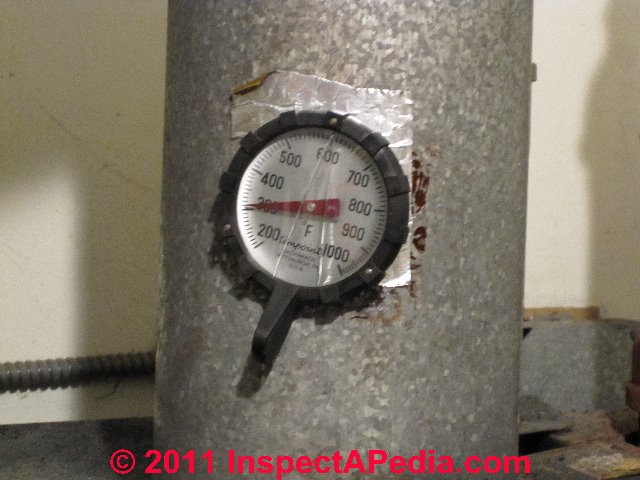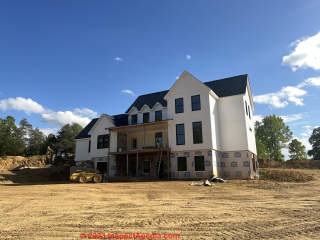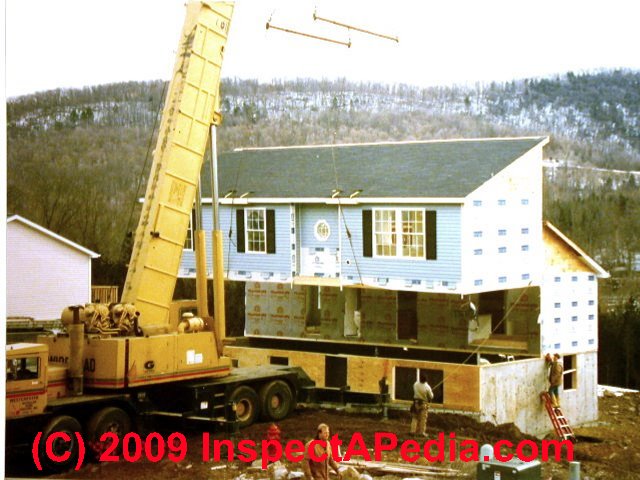 New Home Inspections
New Home Inspections
What to look for at final walk-through inspections & new construction inspections
- POST a QUESTION or COMMENT about the inspection of new construction of homes & light commercial buildings
New home inspections & walkthroughs:
Advice on what to look for & how to inspect new construction.
This article describes procedures for new home walkthrough inspections and suggests topics to examine closely during a home inspection of newly-constructed buildings.
InspectAPedia tolerates no conflicts of interest. We have no relationship with advertisers, products, or services discussed at this website.
- Daniel Friedman, Publisher/Editor/Author - See WHO ARE WE?
New Construction Inspections & Walk-Throughs: what to look for
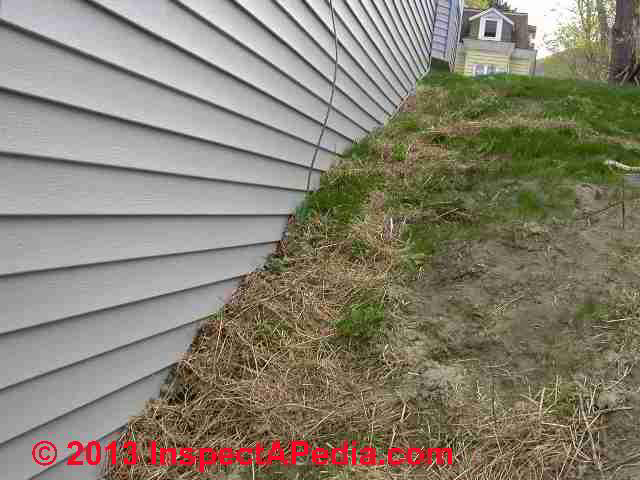 Reader Question:
Reader Question:
Going with my clients to a new home construction walkthrough. What should I look for? What are the items that are typically missed by the builders - - or are problematic right off the bat? Thanks for any advice – much appreciated.
Reply: what's the difference between a home inspection and a walk-through?
First, let's distinguish between a "walk-through" and a professional home inspection.
A Walk-Through Inspection is an inexpert and often hasty trip through a building made by a prospective new owner, usually 24 hours before going to the closing of a sale. This sort of inspection cannot find every significant defect in the home and probably it cannot even find most of them. What a walkthrough inspection can and should do is look for obvious trouble such as the following:
- Is the property still there, intact, and free of some unexpected catastrophe?
We don't want to go to a home sale closing, pay off the seller, then drive to the property to discover that it burned down or blew away the night before. - Is there any obvious visible damage:
vandalism, something broken, flooded, burned? - How "finished" is the building exterior:
are all finish siding, trim, windows, doors, locks, lights, walks, drives, decks, porches installed and complete? Are the roof gutters, downspouts, footing drains complete and visible and taken away from the building?
See MISSING GUTTER, DOWNSPOUT .
I inspected a new home in New York. The architect who designed and built the spec home walked around with me (ick). I noticed that there were no gutters installed. "I hate gutters, they are ugly, so I never put them on my homes!" he extolled.
"Don't you ever have water entry problems in the homes you build?" I asked. "Nope, I've been building here in the Hudson Valley for twenty three years and none of my homes ever had a wet basement" he explained, smirking at my pettiness.
We walked inside and down into the basement where there was an inch of water all over the floor. - Does everything that should work actually work:
all appliances start, run through a normal cycle and stop normally without obvious noises, backups or failures?
Do all of the plumbing fixtures work: hot water, cold water, drainage, toilets, tubs, showers? If I fill a bathtub up to its overflow fitting, does the overflow drain or does water fall out of the ceiling below? Does the whirlpool spa motor start when the tub is full?
Does the heat work in response to thermostat settings? Same for air conditioning? - Are there implementation defects that haven't caused trouble yet but surely are going to?
For example if building siding has been buried by backfill the home may be an engraved invitation to wood-destroying insects. The home may not even have had a "termite inspection" since it's new, and even if inspected no insect pests may have been observed - but they're coming. - Leave plenty of time:
two hours or more: you need time to see that appliances run normally and that every accessible area can be at least entered and examined. Rushing to a final walk-through fifteen minutes before going to the real estate closing is worthless. - If a substantive problem is observed
this does not mean that the closing of sale cannot proceed; it may be possible to agree to an escrow fund to protect the parties involved while further expert inspections, tests, or if necessary, repairs are performed.
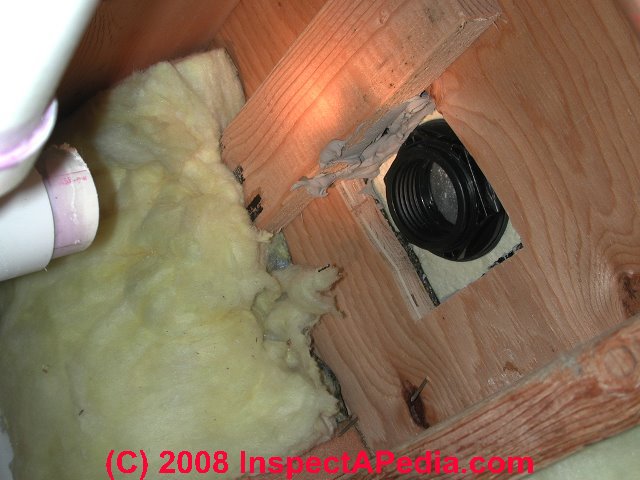 A professional home inspection is far more thorough than a walkthrough inspection and in most U.S. states and Canadian provinces must be conducted to meet a minimum standard of thoroughness.
A professional home inspection is far more thorough than a walkthrough inspection and in most U.S. states and Canadian provinces must be conducted to meet a minimum standard of thoroughness.
All of the substantive physical components of the building and its mechanical systems are usually included, inspected, operated, or where appropriate, tested.
The professional inspector, recognizing the kind of construction (stick framed, modular, panelized) and materials (poured concrete vs. concrete block foundation) knows to look for specific defects or problems associated with those construction methods and materials - or should.
The following are simply examples of how a professional inspector may have an eye for trouble that a normal home buyer or real estate agent will not::
- The home inspector, if she or he is awake, might notice that there are no plumbing vents appearing up through the building roof - raising a question about how the building drain waste vent system was installed
PLUMBING VENT PIPING - Included, perhaps by special arrangement, might be a septic test (if the home is not connected to a public sewer - but an astute home inspector might explain why such a test may be bogus - or not.
HOME BUYERS GUIDE to SEPTIC SYSTEMS. - Excluded are usually environmental concerns, legal encumbrances and similar topics beyond a normal home inspection scope.
At HOME INSPECTION, GET THE MOST FROM we describe the typical scope of a professional home inspection.
Inspecting New Construction: where troubles lies in wait
A competent onsite inspection by an expert usually finds additional clues that would permit a more accurate, complete, and authoritative answer than we can give by email alone. You will find additional depth and detail in articles at our website.
That said I have to explain that the question you asked is a bit broad for a simple email reply. It's as if I wrote to you and said I'm about to enter into a negotiation, could you please tell me everything I need to know?
Some time ago I wrote some material on new home inspections but I couldn't immediately put my hands on it today. I'll look further for that information, format it online if needed, and send you that for guidance and to invite your comment.
A more general answer is that indeed new home concerns are very different from older home inspection concerns in these regards:
- There are normally no historic visual clues
of the leak, age, wear and tear, sort to point us to existing problem areas; - Rather, substantive defects or problems tend to be ones of omission
(failure to provide working footing drains, improper plumbing pipe installation) or of commission (improper flashing around a chimney or at a roof-wall intersection ) that may not be immediately obvious but will show up over time.
Example: ROOF-WALL FLASHING SNAFU - Therefore an astute home inspector examining a new home looks closely at building practices,
details of execution, for clues that may suggest implementation errors. Some of these can be tricky to spot, in fact most of them are. For example: in a finished basement, is a supporting column omitted? - I'm doubtful that a real estate professional is going to be equipped to spot these issues
except for some that may be particularly egregious - early failures for example. Even hiring a home inspector may be of only limited value unless the inspector has experience and expertise in new construction and good building practices across ALL of the trades and specialties involved. Otherwise s/he simply won't recognize evidence of commission or omission errors. - What you can do is make sure that all required permits and building code compliance inspections were obtained
and that there are no open issues with the building department (which is useful but is NO assurance that there won't be costly or even dangerous defects).
Knowing who the builder was and his/her track record may also be helpful; When I inspect a new building I check with owners of other new structures put up by the same builder if possible, asking what went well, what went wrong, and how the builder responded when post-sale or new home warranty issues arose. - An example or two:
Some more general and very common new construction snafus and defect topics are given below as examples. - Open, close, run and test everything
that can be run at your walk-through of a new home or of any home before closing sale.
Appliance, cabinets, doors, window defects:
There may also be interior questions about what work remains: fixtures, cabinets, appliances; lesser (in terms of percent of property value) issues may arise and be discovered simply by running every plumbing fixture and appliance, opening and closing every window and door - just to discover what things were not finished, or don't work.
It can be a surprise to discover later that three windows don't stay up or don't latch - a too-late surprise now because nobody looked at them while the home was still under warranty or while the builder or seller was under obligation to deliver what was promised.
Roof & Site Drainage incomplete:
often the builder's contract considers a home "complete" with no gutters and leaders installed, or with only rough site grading and no finish grading; a result can be a basement flood - perhaps not immediately, but rather as soon as soil clogs the footing drains (if there are any). I'd look for gutters, leaders, and for footing drains taken to daylight as examples of visual clues that are easy to spot.
Incomplete work:
if the inspector sees indications that work at the property appears incomplete, s/he should give a notice similar to the one we quote here:
NOTICE: construction work was incomplete at time of our inspection. Our assessment of building condition as summarized below presumes that the builder will complete normal construction tasks such as site work, siding, mechanical hookups, and interior finishing.
Where we feel it is useful we will
note some of the areas of incomplete work, suggesting finish details to watch
for. But in new, incomplete construction we do not call out such items as
deficiencies. Should the builder fail to complete the project, naturally
such items would then be raised as deficiencies.
more subtle clues indicating important building defects need an expert: if I look at an oil fired heating appliance and see no test instrument hole in the flue vent connector I know that somebody "hooked it up" but no one has properly set up the system to run safely and economically.
(OIL BURNER INSPECTION & REPAIR)
Settlement cracking:
It is common for new houses to develop new shrinkage and settlement cracks in the first one or two years after construction--defects not present at an intial inspection. Such may raise questions that need review.
If the new homeowner has questions about indications of cracking, movement, or out of level building foundation, walls, ceilings, doors that stick, windows that jam or similar current or future defects or about maintaining the property s/he should call their home inspector before you commiting funds to a contractor.
There should no additional fee for such follow-up questions and advice from a neutral professional can be invaluable.
...
Reader Comments, Questions & Answers About The Article Above
Below you will find questions and answers previously posted on this page at its page bottom reader comment box.
Reader Q&A - also see RECOMMENDED ARTICLES & FAQs
On 2023-11-07 by Amie - will our new house pass a home inspection by a buyer?
We've been building a new home for nearly 3 years...contractor is very talented and nice as can be, but it's been a nightmare and the slowest process I've ever experienced.
Hoping to be in the new house within a few months. (I'll include a pic, just for fun. Lol) But getting nervous about this house passing inspection for a potential buyer.
We are crossing our fingers a friend of ours will be purchasing it and handling the necessary repairs to re-sell or rent it out. Of course, he knows of the issues up front and is a contractor himself...has experience with this nonsense.
On 2023-11-07 by InspectApedia Publisher - be clear about what a home inspection should include and its purpose
@Amie,
In my opinion a home inspection never passes or fails a house. That's the wrong terminology.
A proper home inspection identifies work that's needed and helps set priorities for repairs by identifying things that are dangerous, causing rapid costly damage, or simply don't work as they are needed to perform.
Also a house that's right for one buyer may not be right for another.
When I first started restoring buildings I particularly liked to find buildings in terrible condition because those were the ones that I could afford.
Other home buyers who are not handy or have a not budgeted for repairs are better off with a home that doesn't need a lot of upfront repair.
...
Continue reading at NEW HOME / SPEC HOME DEFECTS & REPAIRS or select a topic from the closely-related articles below, or see the complete ARTICLE INDEX.
Or see these
Recommended Articles
- BUILDING DEFECTS LISTS - home
- FRAMING DAMAGE, INSPECTION, REPAIR - home
- HOME & BUILDING INSPECTION - home
- HOME & BUILDING INSPECTION METHODS
- HOME INSPECTION, GET THE MOST FROM
- NEW HOME / SPEC HOME DEFECTS & REPAIRS
Suggested citation for this web page
NEW HOME INSPECTIONS at InspectApedia.com - online encyclopedia of building & environmental inspection, testing, diagnosis, repair, & problem prevention advice.
Or see this
INDEX to RELATED ARTICLES: ARTICLE INDEX to BUILDING & HOME INSPECTION
Or use the SEARCH BOX found below to Ask a Question or Search InspectApedia
Ask a Question or Search InspectApedia
Try the search box just below, or if you prefer, post a question or comment in the Comments box below and we will respond promptly.
Search the InspectApedia website
Note: appearance of your Comment below may be delayed: if your comment contains an image, photograph, web link, or text that looks to the software as if it might be a web link, your posting will appear after it has been approved by a moderator. Apologies for the delay.
Only one image can be added per comment but you can post as many comments, and therefore images, as you like.
You will not receive a notification when a response to your question has been posted.
Please bookmark this page to make it easy for you to check back for our response.
IF above you see "Comment Form is loading comments..." then COMMENT BOX - countable.ca / bawkbox.com IS NOT WORKING.
In any case you are welcome to send an email directly to us at InspectApedia.com at editor@inspectApedia.com
We'll reply to you directly. Please help us help you by noting, in your email, the URL of the InspectApedia page where you wanted to comment.
Citations & References
In addition to any citations in the article above, a full list is available on request.
- In addition to citations & references found in this article, see the research citations given at the end of the related articles found at our suggested
CONTINUE READING or RECOMMENDED ARTICLES.
- Carson, Dunlop & Associates Ltd., 120 Carlton Street Suite 407, Toronto ON M5A 4K2. Tel: (416) 964-9415 1-800-268-7070 Email: info@carsondunlop.com. Alan Carson is a past president of ASHI, the American Society of Home Inspectors.
Thanks to Alan Carson and Bob Dunlop, for permission for InspectAPedia to use text excerpts from The HOME REFERENCE BOOK - the Encyclopedia of Homes and to use illustrations from The ILLUSTRATED HOME .
Carson Dunlop Associates provides extensive home inspection education and report writing material. In gratitude we provide links to tsome Carson Dunlop Associates products and services.


